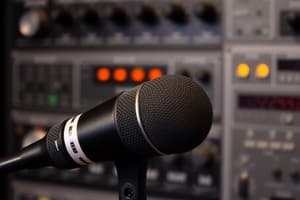Podcast
Questions and Answers
What distinguishes listening from hearing?
What distinguishes listening from hearing?
- Listening occurs without concentration.
- Listening requires conscious effort. (correct)
- Listening is a passive act.
- Hearing involves processing meaning.
Which term refers to the balance and control of multiple sound elements?
Which term refers to the balance and control of multiple sound elements?
- Tone
- Pace
- Mixing (correct)
- Transition
What is the primary feature of a complex tone?
What is the primary feature of a complex tone?
- It has no overtones.
- It contains two or more simple tones. (correct)
- It consists of a single simple tone.
- It has only one frequency.
Which type of transition involves one audio element fading out while another fades in?
Which type of transition involves one audio element fading out while another fades in?
What aspect of sound refers to how strong a sound wave feels to the listener?
What aspect of sound refers to how strong a sound wave feels to the listener?
What is the primary purpose of radio broadcasting?
What is the primary purpose of radio broadcasting?
Which audio storage medium is typically used for recording sound or video?
Which audio storage medium is typically used for recording sound or video?
What does MP3 stand for?
What does MP3 stand for?
Which of the following formats is considered a successor to MP3?
Which of the following formats is considered a successor to MP3?
What is a key feature of an audio podcast?
What is a key feature of an audio podcast?
What distinguishes a WAV file from other audio formats?
What distinguishes a WAV file from other audio formats?
Which option is NOT a method of audio storage mentioned?
Which option is NOT a method of audio storage mentioned?
What type of sound is characterized as sound clips or effects?
What type of sound is characterized as sound clips or effects?
Flashcards
Loudness
Loudness
The loudness of a sound, determined by the strength of the sound wave.
Mixing
Mixing
The combination, balance, and control of multiple sound elements.
Silence
Silence
The absence of audio.
Cross-fade
Cross-fade
Signup and view all the flashcards
Listening
Listening
Signup and view all the flashcards
Radio Broadcast
Radio Broadcast
Signup and view all the flashcards
Audio Podcast
Audio Podcast
Signup and view all the flashcards
Sound Effects
Sound Effects
Signup and view all the flashcards
CD (Compact Disc)
CD (Compact Disc)
Signup and view all the flashcards
Tape
Tape
Signup and view all the flashcards
USB Drive
USB Drive
Signup and view all the flashcards
Memory Card
Memory Card
Signup and view all the flashcards
Computer Hard Drive
Computer Hard Drive
Signup and view all the flashcards
Study Notes
Audio Information and Media
- Audio information encompasses various forms of sound, including radio broadcasts, music, sound recordings, sound clips/effects, audio podcasts, and more.
- Different methods exist for storing audio media, such as tape, CDs, USB drives, memory cards, computer hard drives, and cloud storage.
- Common audio file formats include MP3, M4A/AAC, WAV, and WMA.
Types and Categories of Audio Information
- Radio broadcast involves live or recorded audio transmitted via radio waves to a wide audience.
- Music combines vocal and/or instrumental sounds to create beauty, harmony, and emotional expression.
- Sound recordings capture any audio, encompassing interviews, meetings, or environmental sounds.
- Sound clips/effects use sound other than music or speech to enhance a dramatic presentation, like storm sounds or door creaks.
- Digital audio or video files often form themed series, which are available for download to media players or computers.
Ways of Storing Audio Media
- Tape uses magnetic tape to record sound.
- CDs use a plastic circular medium to record, store, and play back audio, video, and computer data.
- USB drives are portable flash drives used with computers.
- Memory cards are small storage devices typically used in portable devices.
- Computer hard drives are secondary storage devices for audio files,
- Internet/Cloud storage uses websites or file repositories to store and retrieve audio files online.
Audio File Formats
- MP3 is a common consumer audio format for transferring and playing music on most audio players.
- M4A/AAC is a lossy audio format known for better sound quality compared to MP3.
- WAV is used as a standard for storing audio bitstreams on PCs.
- WMA is audio data compression developed by Microsoft, commonly used with Windows Media Player.
Hearing vs. Listening
- Hearing is the biological act of perceiving sound by the ear.
- Listening is the conscious act of paying attention to and trying to understand sound and meaning.
Sound Characteristics and Purposes
- Sound volume refers to the loudness or quietness of a sound.
- Sound tone is the regularity in the sound's vibration.
- A simple tone includes just one sound frequency.
- A complex tone combines several tones with varying frequencies.
- Pitch is the position of a sound within a complete sound range.
- Loudness reflects the intensity or strength of a sound wave.
Characteristics of Sound
- Volume describes how loud or soft a sound is.
- Tone is a sound identified by its regular vibrations.
- Pitch is the specific position of a sound within a range.
- Loudness represents how strong a sound wave is.
Elements and Principles of Sound Design
- Dialogue includes speech, conversations, and voice-overs.
- Sound effects comprise all sounds other than music or dialogue
- Music is vocal or instrumental combined for emotional expression.
- Silence is the absence of sound.
Mixing, Pace, Transitions
- Mixing combines and adjusts multiple sound elements.
- Pace involves editing and controlling linear, non-linear, or multi-linear sound order.
- Transitions are methods for moving between sound segments from one to another. Various transition methods exist, such as segue, cross-fade, and V-fade
- Stereo imaging uses left and right channels to create depth in sound.
Studying That Suits You
Use AI to generate personalized quizzes and flashcards to suit your learning preferences.




